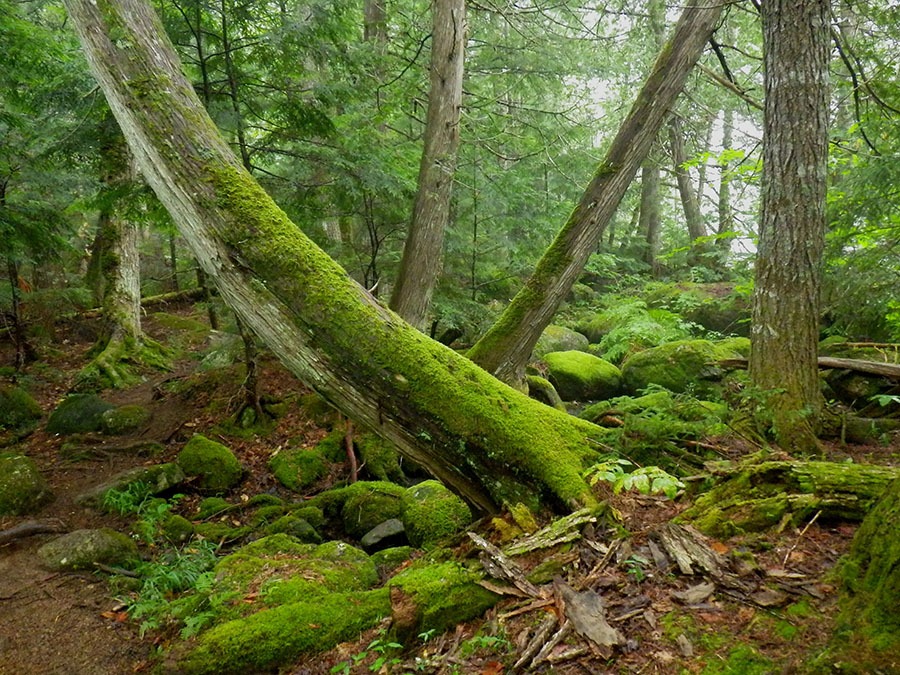By Jack Igelman
A Dynamic Approach to Landscape Conservation
“We all champion the same thing: maintaining a sense of place, clean water, beautiful views, remoteness — those values are just as important to the people who live near the Trail as they are to a thru-hiker.”
–Laura Belleville, ATC’s Vice President of Conservation and Trail Programs
To grasp the impact of a successful large-scale landscape partnership approach that helps preserve the Appalachian Trail — or the “Wild East,” — it is helpful to examine Maine’s North Woods. In 2001, Walter Graff, the senior vice president of the Appalachian Mountain Club (AMC), helped establish the largest town-owned forest in New Hampshire that encompasses over 10,000 acres in his hometown of Randolph. While that project was a grassroots community effort, it paralleled his decades-long career at the AMC, an organization that is no stranger to major conservation projects.

Maine’s 100-Mile Wilderness includes a section of the Appalachian Trail beginning in Monson and ending at Abol Bridge just south of Baxter State Park. Surrounded by tracts of public and private land, it is famous for its remoteness. Photo by Steve Rincavage
“When we created a town forest we did it as volunteers. That got me thinking, can the AMC do this somewhere else?” Graff said. While his contemplation would represent a new frontier in the AMC’s conservation playbook, it coincided with one of the largest land ownership changes in the northeastern U.S. in nearly a century. An upheaval in the timber industry preceded the transfer of ownership of hundreds of thousands of acres of commercial timberland throughout the state of Maine in the late 1990s.
Soon the AMC, as well as other conservation advocates and organizations, swept in to protect some of Maine’s most special and remote places. For example, in 2003, the AMC purchased the first of several sprawling tracts that formed the nucleus of the AMC’s Maine Woods Initiative (MWI) — a project that combines outdoor recreation, resource protection, sustainable forestry, and community partnerships in Maine’s 100-Mile Wilderness region. In all, the MWI encompasses a contiguous stretch of over 70,000 acres of permanently conserved land. The thriving venture is one of several large-scale landscape projects that has placed in permanent protection thousands of acres of some of New England’s most remote and remarkable terrain that is adjacent to or encompasses the Appalachian Trail.
The success of the MWI is an example of an ambitious approach to land protection that the Appalachian Trail Conservancy (ATC), the National Park Service, and many of its partners — including the AMC — is working toward. A kaleidoscope of organizations, from small volunteer groups to sprawling federal agencies, have championed this approach in order to protect the Trail’s landscape. Together, these conservation partners represent a coalition known as the Appalachian Trail Landscape Partnership.
The partnerships between the ATC and its conservation partners take many forms. Dennis Shaffer, the ATC’s Director of Landscape Conservation, points out that as conservation projects expand beyond the Trail corridor, they will likely become vastly more complex and will depend on a division of labor supplied by a diverse range of partners. “Our partners bring to the table a wide range of capacity and expertise. Our role with AMC has been more to help promote and celebrate the huge successes of their Maine Woods Initiative and to make the connection that this important work in Maine contributes to the entire A.T. landscape,” Shaffer explains. “But our work with partners such as AMC also goes well beyond specific projects areas like the MWI. We work closely on issues important to the entire A.T. landscape such as conservation funding initiatives, federal and state legislative issues, and active threats such as inappropriately planned pipelines or communications facilities.”
At the core of a successful landscape-level conservation project in the A.T. landscape is helping support and bolster the communities that lie within it. Putting the environmental benefits aside, protecting the landscape may be an enticing draw to future visitors to Maine and a viable option for bolstering the vitality of communities that are looking for other ways to diversify their economic base and generate income from a working landscape. And while the scale of conservation in the North Woods may not be possible to replicate in other regions of the Appalachians, if the success in Maine serves as a guide, then engaging communities and building meaningful partnerships will most likely remain the cornerstone of the ATC’s future conservation strategy for a long time to come.
 This was adapted from Jack Igelman’s piece “The Future of Landscape Conservation,” which appeared in the Fall 2017 edition of A.T. Journeys magazine. Jack is a freelance writer based in Asheville, North Carolina and has been a regular contributor to A.T. Journeys since 2011. As a former North Carolina Outward Bound School instructor, he has a deep appreciation for how trails can transform lives and why we should protect them. Jack is also a regular contributor to Carolina Public Press and WNC Magazine. Follow him on Twitter @ashevillejack.
This was adapted from Jack Igelman’s piece “The Future of Landscape Conservation,” which appeared in the Fall 2017 edition of A.T. Journeys magazine. Jack is a freelance writer based in Asheville, North Carolina and has been a regular contributor to A.T. Journeys since 2011. As a former North Carolina Outward Bound School instructor, he has a deep appreciation for how trails can transform lives and why we should protect them. Jack is also a regular contributor to Carolina Public Press and WNC Magazine. Follow him on Twitter @ashevillejack.





